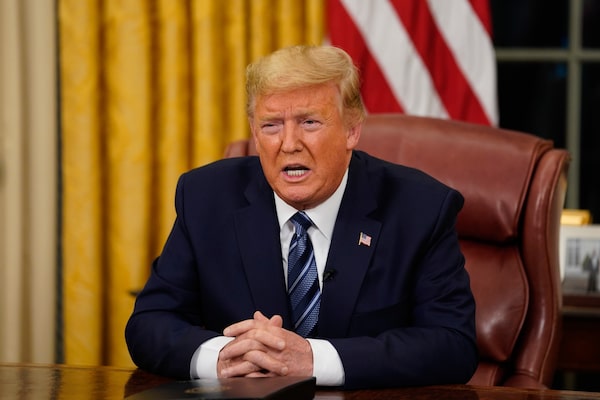
President Donald Trump speaks in an address to the nation from the Oval Office at the White House about the coronavirus on March 11, 2020, in Washington. One top public-health official conceded Thursday that the U.S. did not have the infrastructure to process large numbers of tests, accounting for the government’s flagging response to the virus.Doug Mills/The Associated Press
President Donald Trump is facing growing criticism over his handling of the new coronavirus pandemic as he continues to play down its seriousness, the U.S. severely lags other countries in testing for the infection and congressional leaders tussle over a relief package.
The frustration with the White House mounted a day after Mr. Trump announced a travel ban on 26 European countries – a move public-health experts said would be ineffectual in stopping the virus and former vice-president Joe Biden described as “xenophobic” – but failed to unveil measures to stem infections in the U.S.
Mr. Trump had intended the measure to soothe economic fears by projecting presidential authority. Instead, markets saw their largest single-day fall since the stock market plunge of 1987.
One top public-health official conceded Thursday that the U.S. did not have the infrastructure to process large numbers of tests, accounting for the government’s flagging response to the virus.
“The system is not really geared to what we need right now, what you are asking for. That is a failing. Let’s admit it,” Anthony Fauci, director of the National Institute of Allergy and Infectious Diseases, told a congressional committee. “The idea of anybody getting [the test] easily the way people in other countries are doing it, we’re not set up for that.”
According to figures from the Centers for Disease Control, the U.S. has processed more than 11,000 coronavirus tests. By comparison South Korea, a country that has roughly one-sixth the U.S. population, has tested 230,000 people.
Officials have blamed several factors: Initially, the CDC issued a faulty test and did not allow local authorities to use other tests. The CDC has also said it does not have enough personnel or lab space to process large numbers of tests. And stringent criteria for receiving the test meant most people could not take it even if they were exhibiting symptoms.
But speaking to reporters in the Oval Office Thursday, Mr. Trump claimed the testing was “going very smooth.” And he insisted that Britain, which he exempted from the travel restrictions, didn’t “have very much infection,” even though its 460 cases are more than in 12 of the countries subject to the ban.
Mr. Trump also refused to be tested for coronavirus after a photograph emerged of him standing next to Brazilian President Jair Bolsonaro’s press aide, who was confirmed Thursday to have the infection, at Mar-a-Lago last weekend.
“We sat next to each other for a period of time, had a great conversation,” Mr. Trump said. “Let’s put it this way: I’m not concerned, okay?”
Democratic Speaker Nancy Pelosi unveiled a package of proposed relief measures, including free testing, paid sick leave and expanded employment insurance. Ms. Pelosi said Thursday she was in negotiations with Treasury Secretary Steve Mnuchin over the bill.
Republican Senate Leader Mitch McConnell derided the legislation as an “ideological wish list” but said the Senate would cancel a planned break next week to work on it.
Mr. Biden, the front-runner for the Democratic presidential nomination, accused Mr. Trump of “xenophobia” for calling COVID-19 a “foreign” ailment and deciding the best measure was to ban people from the U.S.
“Labelling COVID-19 a ‘foreign virus’ does not displace accountability for the misjudgments that have been taken thus far by the Trump administration,” he said in Delaware.
Bernie Sanders, his rival for the nomination, called for an “emergency bipartisan group of experts” to take control of the coronavirus response away from Mr. Trump.
“In this time of international crisis, the current administration is largely incompetent, and its incompetence and recklessness have threatened the lives of many people,” he said.
While the federal government’s response lagged, private companies, and state and local authorities, announced strident measures. All major sports leagues cancelled games. Some states shut down public schools. New York’s Broadway theatres closed.
In Washington, Congress cancelled tours after at least one staffer tested positive. Universities moved classes online. And major employers, including the World Bank, put a hold on all travel and asked staff to work from home.
Nina Yamanis, a public-health expert at American University in Washington, said there was no reason for Mr. Trump’s travel ban because the virus is already spreading in the U.S. between people who have not visited foreign countries.
On top of massively scaling up testing, Prof. Yamanis said, the U.S. government must also be more proactive in encouraging people to limit contacts to avoid spreading the disease.
“We need a federal message that’s strong, that says ‘we all should be socially distancing, not just cancelling big events, but staying at home,’” she said. “In 40 days, we could have a million cases. That’s the kind of trajectory we’re on.”
The spread of the novel coronavirus that causes COVID-19 continues, with more cases diagnosed in Canada. The Globe offers the dos and don'ts to help slow or stop the spread of the virus in your community.
The Globe and Mail
 Adrian Morrow
Adrian Morrow